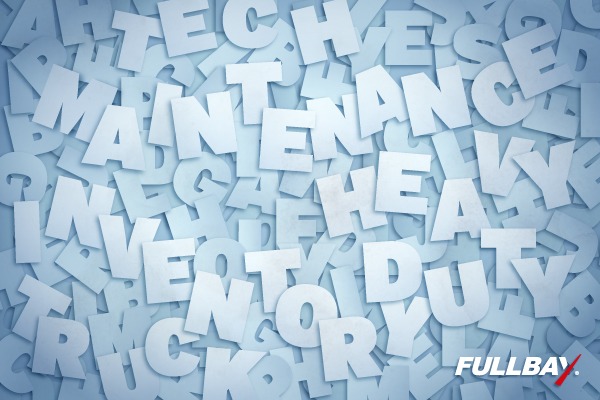Essential Heavy-Duty Terms, Acronyms, & More

There are a lot of terms in the heavy-duty industry.
Like, a lot.
The writing team ends up doing a lot of research (for clarification, research usually means a lot of Googling and/or bombarding the rest of the crew with questions like “What does this term mean?” “Hey, what about that acronym?”).
We started compiling a list for our own reference.
That list kept growing.
And growing.
And…you get the idea.
We decided to put it here for posterity and for anyone else who is curious about the industry and/or always wanted to know what this or that term meant.
We only want to warn you that this list is merely exhausting – not exhaustive – (heh, exhausting…we’re so funny). We’ll be adding to it over time, so don’t print it out yet!
Ready to learn the difference between EOT and fleet management? Let’s go!
- 2V – Two valves per engine cylinder
- 3V – Three valves per engine cylinder
- 4V – Four valves per engine cylinder
- 4WD – Four-Wheel Drive
- ABS – Anti-lock brake system
- Accounts Receivable – money your customers owe you
- Aftermarket – Equipment made by someone besides the original manufacturer
- AG Equipment – Agricultural equipment
- Alternative fuels – A propellant that isn’t derived from fossil fuels
- ATA – American Trucking Association
- API – American Petroleum Institute
- Backflushing – Cleaning contaminants out of a system
- Biodiesel – Diesel fuel made from plants or animals that is compatible with regular diesel engines
- B100 – A biodiesel system
- B10 – Method of approximating diesel engine service life
- B20 – Common biodiesel blend; 20% biodiesel, 80% petroleum diesel
- B50 – Method of approximating diesel engine service life
- Brake pots – Nickname for brake chamber or brake can
- Bulkhead – A way cooler word for wall.
- Buying in bulk – Buying multiples of one item to keep costs down; similar to wholesale
- Canned Job – A basic service or procedure that requires a set amount of time and can be performed for a set amount of money (for example, an oil change for $100 within one hour); also called global service
- CARB – California Air Resources Board
- Carbon Deposits – Buildup that occurs while burning gasoline
- CEC – California Energy Commission
- CDL – Commercial Driver’s License – you need one of these to drive a big rig
- CEL – Check engine light
- Cells – Slang for battery
- Collision avoidance system – Warns you when you’re getting too close to another vehicle
- Cores and/or Dirty Cores – A used part that can be turned into revenue
- CP3 – Injection pump produced by Bosch, found in various Duramax and common rail Cummins engines
- CP4 – Injection pump produced by Bosch, found in various modern common rail diesels
- CVIP – Canada’s Commercial Vehicle Inspection Program
- Customer portal – Software that allows you to communicate with customers without needing phone calls or face-to-face interaction
- Deadheading – Making a trip without cargo or passengers
- Derated – When a truck has something wrong with its engine and it self-limits how much it can do
- DEF – Diesel exhaust fluid
- DFA – Diesel fuel additive
- Diagnostics – Determining what’s wrong with a vehicle or part
- Diesel fuel – Liquid fuel that is often more efficient than regular gasoline
- Direct Injection Diesel – An engine where fuel is injected directly into the cylinder
- DEAC – Diesel Engine Anti-freeze/coolant
- DVIR – Driver-Vehicle Inspection Report
- DMM -Digital Multimeter
- DOC – Diesel Oxidation Catalyst
- DPF Differential Pressure Sensor
- DOT – Department of Transportation; performs the dreaded DOT Inspection
- DPF – Diesel particulate filter
- Dry service – Just an inspection; no oil or filter change
- DTC – Diagnostic trouble code
- ELD – Electronic Logging Device that is fixed to an engine and records driving hours
- Emissions – Gasses, particles, etc that leave a truck & go into the air via the exhaust system
- Environmental fees – How your shop recoups costs associated with recycling parts
- ESN – Engine Serial Number
- E10 – Gasoline containing 10% Ethanol
- E85 – Gasoline containing 85% Ethanol
- ECM – Engine control module
- EGR Cooler – Lowers the temps in the exhaust gas recirculator
- EOT – Engine oil temperature
- Engine hours – The hours your engine has been running; used for preventive and predictive maintenance
- Fleet management – Oversee the operations, maintenance, and more of a carrier’s vehicles
- Fault Code – The way a truck communicates an error/problem to a tech
- FMCSA – Federal Motor Carrier Safety Administration
- GCWR – Gross combined weight rating
- Gladhand – Connects hoses bringing pressurized air to air brakes; yes, they look like a handshake
- Glow Plug – Heating device that starts a diesel engine without a spark (and yes, it glows)
- GPS – Global Positioning System
- GTWR – Gross trailer weight rating
- GVWR – Gross vehicle weight rating
- HDD – Heavy-duty diesel
- HDDO – Heavy-duty diesel oil
- HDDT – Heavy-duty diesel trucks
- HDE – Heavy-duty engine
- HDGT – Heavy-duty gasoline trucks
- HDMO – Heavy duty motor (diesel engine) oil
- HDT – Heavy-duty trucks
- HDVIP – Heavy-Duty Vehicle Inspection Program
- HOS – Hours of Service regulated by the FMCSA
- Intercooling – Cools gas following compression
- In-frame – Rebuilding an engine while it’s still bolted to the frame
- Invoiced hours – How much labor you’re charging a customer for
- KOEO – Key on engine off
- KOER – Key on engine running
- LDT – Light-duty truck
- LDV – Light duty vehicle
- LEV – Low-emission vehicle
- Labor guide – Tells you how long a job should take & what tools you need to complete it.
- Labor hours – How many hours are necessary for a service or repair
- Labor rates – How you decide what to charge for the work a technician does
- LOF – Lube, oil, and filter
- Lubricant – Lessens friction between surfaces
- Mobile repair unit – A repair truck + tech that meets & serves customers on the road
- MVI – Motor Vehicle Inspection
- NOx – Nitrogen Oxides
- OBD – On-board diagnostic system, used in reference to the OBD-I and OBD-II diagnostic system protocols
- Ohmmeter – Measures electrical resistance
- ON HWY – On Highway
- Onboarding – Acclimating a new employee to the workplace
- OFS – Offshore
- OEM – Original Equipment Manufacturer
- OSHA – Occupational Safety and Health Administration
- Owner-operator – Usually an individual who owns & drives their truck (and may work under contract for a carrier)
- Parasitic battery drain – When the battery continues to discharge even though the vehicle is off
- P&L – Pump & Line
- Parts markup – The amount of money you charge on top of what you paid a vendor for a part to ensure you make some profit off it
- Parts manager – Oversees the parts department & ensures everyone has the parts they need
- Pre-trip inspection – Checking out a vehicle before it sets out on a journey
- PMs – Preventive maintenance, which helps you stop potential problems before they start
- PM Schedule – Details what kind of preventive maintenance a vehicle needs at what point in its life
- Predictive maintenance – Uses data to determine what maintenance a unit will need
- PSI – Pound-force per square inch
- Purchase orders – An invoice from when you purchase a part or equipment
- QuickBooks – Accounting software
- Reefer unit – refrigeration for box trucks and trailers
- ROI – Return on Investment
- Service manager – The branch between customers and technicians
- SO – Service order, also called a repair order (RO)
- Shop management software – an app that helps you run your shop more efficiently, like Fullbay
- Schematic – a detailed diagram of a system
- Service call – when a tech travels off-site for a job
- Service requests – When someone asks for a repair or service on a truck
- Service writer – Someone who books jobs and assigns work to techs; keeps everyone on track
- Shop culture – The overall working environment in a shop
- Shop layout – How a shop is set up
- Shop efficiency – How fast your shop is getting things done
- Shop productivity – How much work your shop is actually doing
- Spongy brakes – Brakes that feel, well, spongy; often caused by air in the brake line
- Sublet – Hiring another vendor to make a repair
- Technician – A mechanic; someone who works on vehicles
- Technician efficiency – How much work your tech is getting done in a set amount of time
- TIER 1 – Emission Standards Effective 1996-2000 By Industry
- TIER 2 – Emission Standards Effective 2001-2006 By Industry
- TIER 3 – Emission Standards Effective 2006-2008 By Industry
- TIER 4 – Emission Standards Effective 2008-2015 By Industry
- Torque – Rotational force; part of an engine’s power output
- Tow truck – A vehicle that repairs or tows a damaged, otherwise immobile unit. Also known as a wrecker.
- Truck classes – there are eight, and you can see a list here
- TPMS – Tire Pressure Monitoring System
- Unit – A vehicle, whether it’s a truck, tractor, or something else
- Upfit – Modifying or customizing a vehicle to your specific needs
- Vendor – Someone you purchase goods (such as equipment and parts) from
- VIN – Vehicle Identification Number; decode yours here
- Voltage – Electrical pressure that allows electrons to do their job
- Wet service – Inspection with an oil and filter change
- Wiring diagram – A visual depiction of the wires and connections in a part or unit
- Yellow iron – Various types of heavy equipment found in construction; earth-moving equipment, quarrying equipment, and fork lift trucks
- Zerk – a fitting on the wheel that allows you to lubricate it; also called “grease nipple”
So how was that? Are you feeling educated yet? Are we missing some cool terms? Let us know on social media – we’ll continue to add to this list over time!

